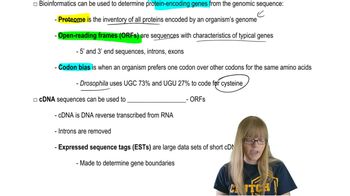Amino acids are classified as positively charged, negatively charged, or electrically neutral.
How does acetylation of lysine affect its interaction with DNA, and how is this related to the activation of gene expression?
Table of contents
- 1. Introduction to Genetics51m
- 2. Mendel's Laws of Inheritance3h 37m
- 3. Extensions to Mendelian Inheritance2h 41m
- 4. Genetic Mapping and Linkage2h 28m
- 5. Genetics of Bacteria and Viruses1h 21m
- 6. Chromosomal Variation1h 48m
- 7. DNA and Chromosome Structure56m
- 8. DNA Replication1h 10m
- 9. Mitosis and Meiosis1h 34m
- 10. Transcription1h 0m
- 11. Translation58m
- 12. Gene Regulation in Prokaryotes1h 19m
- 13. Gene Regulation in Eukaryotes44m
- 14. Genetic Control of Development44m
- 15. Genomes and Genomics1h 50m
- 16. Transposable Elements47m
- 17. Mutation, Repair, and Recombination1h 6m
- 18. Molecular Genetic Tools19m
- 19. Cancer Genetics29m
- 20. Quantitative Genetics1h 26m
- 21. Population Genetics50m
- 22. Evolutionary Genetics29m
13. Gene Regulation in Eukaryotes
Epigenetics, Chromatin Modifications, and Regulation
Problem 24
Textbook Question
A full-length eukaryotic gene is inserted into a bacterial chromosome. The gene contains a complete promoter sequence and a functional polyadenylation sequence, and it has wild-type nucleotides throughout the transcribed region. However, the gene fails to produce a functional protein. List at least three possible reasons why this eukaryotic gene is not expressed in bacteria.
 Verified step by step guidance
Verified step by step guidance1
Eukaryotic genes contain introns, which are non-coding sequences that must be removed during RNA processing. Bacteria lack the splicing machinery required to remove introns, so the mRNA transcribed from the eukaryotic gene would not be properly processed, leading to a non-functional or untranslated mRNA.
Eukaryotic promoters are recognized by eukaryotic RNA polymerase and associated transcription factors. Bacteria use a different set of transcription machinery, including sigma factors, which may not recognize the eukaryotic promoter sequence. As a result, transcription of the gene may not occur.
Eukaryotic genes often rely on specific post-transcriptional modifications, such as the addition of a 5' cap and a poly-A tail, for mRNA stability and translation. Bacteria do not perform these modifications, which could lead to rapid degradation of the mRNA or failure to initiate translation.
The ribosome binding site in bacteria (Shine-Dalgarno sequence) is different from the mechanisms used by eukaryotic ribosomes to initiate translation. If the eukaryotic gene lacks a Shine-Dalgarno sequence, bacterial ribosomes may not be able to bind and initiate translation effectively.
Eukaryotic proteins often require post-translational modifications, such as glycosylation or phosphorylation, to become functional. Bacteria lack the machinery to perform these modifications, so even if the protein is produced, it may not be functional.
 Verified video answer for a similar problem:
Verified video answer for a similar problem:This video solution was recommended by our tutors as helpful for the problem above
Video duration:
5mPlay a video:
Was this helpful?
Key Concepts
Here are the essential concepts you must grasp in order to answer the question correctly.
Promoter Compatibility
Eukaryotic promoters often contain specific sequences and regulatory elements that are recognized by eukaryotic transcription factors. Bacteria have different promoter structures and require their own sigma factors for transcription initiation. If the eukaryotic promoter is not compatible with bacterial transcription machinery, the gene may not be expressed.
Recommended video:
Guided course

Bacteriophage Regulation
Post-Transcriptional Modifications
Eukaryotic genes undergo several post-transcriptional modifications, including capping, splicing, and polyadenylation, which are essential for mRNA stability and translation. Bacteria do not perform these modifications, so if the eukaryotic mRNA is not properly processed, it may be degraded or not translated into a functional protein.
Recommended video:
Guided course

Post Translational Modifications
Codon Usage Bias
Different organisms have varying preferences for specific codons when encoding amino acids, known as codon usage bias. Eukaryotic genes may contain codons that are rarely used in bacteria, leading to inefficient translation or failure to produce the protein. This mismatch can hinder the overall expression of the eukaryotic gene in a bacterial system.
Recommended video:
Guided course

Bioinformatics
Related Videos
Related Practice
Textbook Question
347
views


